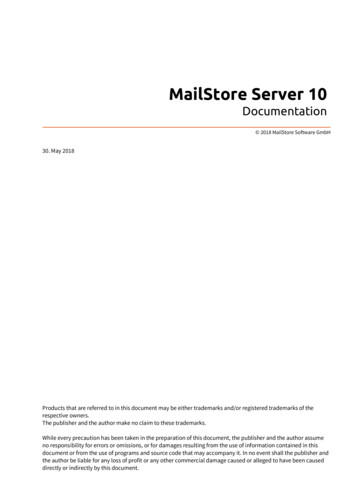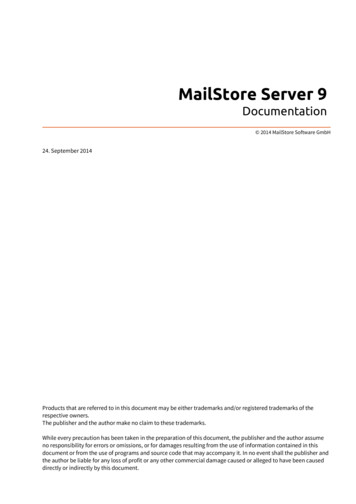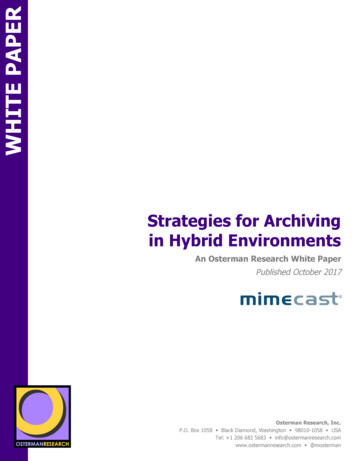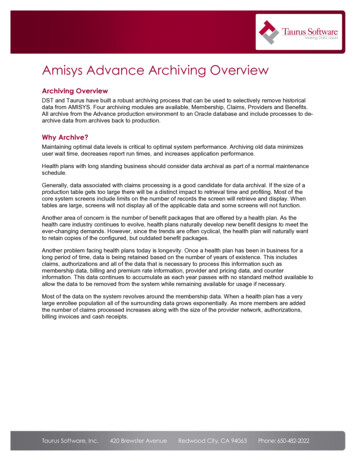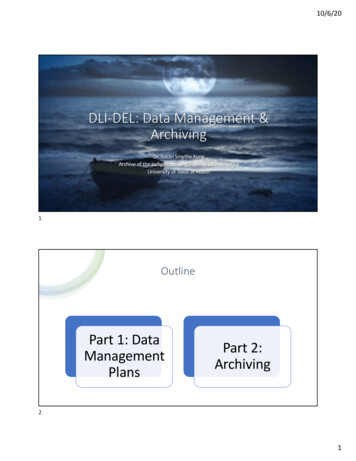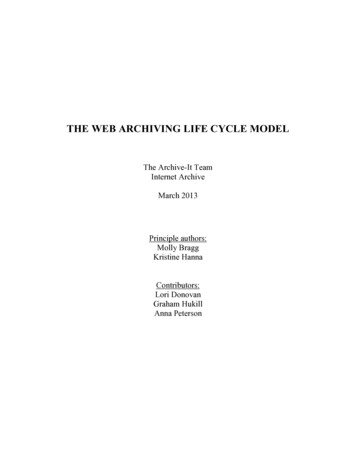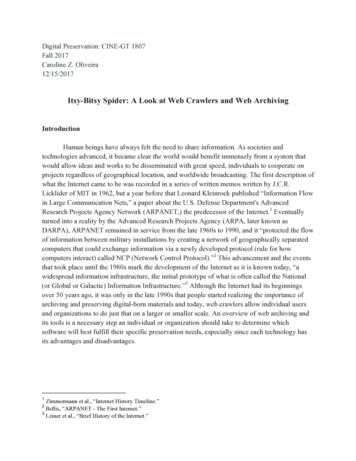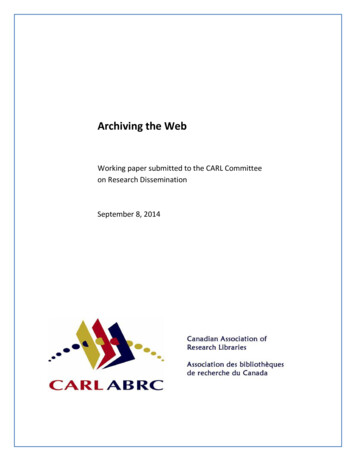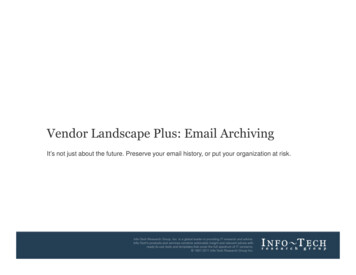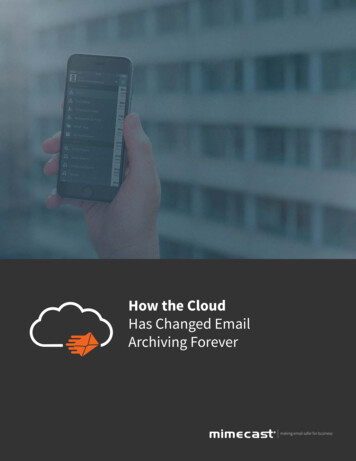
Transcription
BlogForever: From Web Archiving to Blog ArchivingHendrik Kalb, Paraskevi Lazaridou, Vangelis Banos, Nikos Kasioumis, Matthias hmt.itm@cbs.dkAbstract: In this paper, we introduce blog archiving as a special type of web archivingand present the findings and developments of the BlogForever project. Apart from anoverview of other related projects and initiatives that constitute and extend the capabilities of web archiving, we focus on empirical work of the project, a presentation ofthe BlogForever data model, and the architecture of the BlogForever platform.1 IntroductionThe aim of this paper is to introduce blog archiving as a special type of web archiving.Web archiving is an important aspect in the preservation of cultural heritage [Mas06]and, therefore, several projects from national and international organisations are workingon web preservation activities. The most notable web archiving initiative is the InternetArchive1 which has been operating since 1996. In national level, there are several remarkable activities, mainly from national libraries, to preserve web resources of their nationaldomain. For example, the British Library announced this spring a project to archive thewhole .uk domain [Coo13].Web archiving is always a selective process, and only parts of the existing web are archived[GMC11, AAS 11]. The selection seems often to be driven by human publicity and searchengine discoverability [AAS 11]. Furthermore, contrary to traditional media like printedbooks, web pages can be highly dynamic. Therefore, the selection of archived informationcomprises not only the decision of what to archive (e.g. topic or regional focus) but alsoadditional parameters such as the archiving frequency per page, and parameters related tothe page request (e.g. browser, user account, language etc.) [Mas06]. Thus, web archivingis a complex task that requires a lot of resources.All active national web archiving efforts, as well as some academic web archives are members of the International Internet Preservation Consortium2 (IIPC). Therefore, the webarchiving tools3 developed by the IIPC are widely accepted and used by the majority of1 http://archive.org2 http://netpreserve.org3 -software536
internet archive initiatives [GMC11]. However, the approach inherent in these tools hassome major limitations. The archiving of large parts of the web is a highly automatedprocess, and the archiving frequency of a webpage is normally determined by a schedulefor harvesting the page. Thus, the life of a website is not recorded appropriately if thepage is updated more often than it is crawled [HY11]. Next to the harvesting problemof web archiving, the access of the archived information is inadequate for sophisticatedretrieval. Archived information can be accessed only on site or page level according toa URI because analysis and management of current web archiving does not distinguishbetween different kinds of web pages. Thus, a page with a specific structure like blogs ishandled as a black box.The blogosphere, as part of the web, has an increasing societal impact next to traditionalmedia like press or TV. Prominent examples are the influential blogs in political movements in Egypt [Ish08, Rad08] or Iran [Col05]. But there are also other domains thatpeople engage in blogging, e.g. in the fields of arts or science [WJM10], teaching [TZ09]or leisure activities [Chi10]. The blogosphere as an institution has two connotations: Onthe one hand it is considered as a place where people build relationships – the blogosphereas a social networking phenomenon [AHA07, Tia13]. This view is emphasizing the activity of relating to others. On the other hand, it is also important to recognize that thenumerous contributions yield a joint creation - the blogosphere as a common oeuvre, aninstitution shared by all bloggers and readers [KT12]. However, blogs as other social media are ephemeral and some that described major historical events of the recent past arealready lost [Che10, Ent04]. Also the loss of personal diaries in the form of blogs hasimplications for our cultural memory [O’S05].The BlogForever4 project creates a novel software platform capable of aggregating, preserving, managing and disseminating blogs. Through the specialisation in blog archiving,as a subcategory of web archiving, the specific features of the blog as a medium can beexploited in order to overcome limitations of current web archiving.2 Related workIn the following section, we review related projects and initiatives in the field of webarchiving. Therefore, we inspect the existing solutions of the International Internet Preservation Consortium5 (IIPC) for web archiving and the ArchivePress6 blog archiving project.Furthermore, we look into several research projects such as Longitudinal Analytics of WebArchive Data7 (LAWA), Living Web Archives8 (LiWA), SCalable Preservation Environments9 (SCAPE), Collect-All ARchives to COmmunity MEMories10 (ARCOMEM), and4 http://blogforever.eu5 http://netpreserve.org6 http://archivepress.ulcc.ac.uk/7 http://www.lawa-project.eu/8 http://liwa-project.eu/9 http://www.scape-project.eu/10 http://www.arcomem.eu/537
the Memento11 project. Table 1 provides an overview of the related initiatives and projectswe examine in this section.Table 1: Overview of related initiatives and projectsInitiativeArchivePressARCOMEMIIPC projectsLAWALiWAMementoSCAPEDescriptionExplore practical issues around the archiving of weblogcontent, focusing on blogs as records of institutional activity and corporate memory.Leverage the Wisdom of the Crowds for content appraisal, selection and preservation, in order to create andpreserve archives that reflect collective memory and social content perception, and are, thus, closer to currentand future users.Web archiving tools for acquisition, curation, access andsearch.Development of tools and methods to aggregate, query,and analyse heterogenous Internet data at large scale.Develop and demonstrate web archiving tools able to capture content from a wide variety of sources, to improvearchive fidelity and authenticity and to ensure long terminterpretability of web content.Development of a technical framework that integratescurrent and past Web.Developing an infrastructure and tools for scalablepreservation actionsStarted2009201119962010200920092011The IIPC12 is the leading international organization dedicated to improving the tools,standards and best practices of web archiving. The software they provide as open sourcecomprises tools for acquisition (Heritix13 ), curation (Web Curator Tool14 and NetarchiveSuite15 ), and access and finding (Wayback16 , NutchWAX17 , and WERA18 ).They are widely accepted and used by the majority of internet archive initiatives [GMC11].11 http://www.mementoweb.org/12 http://netpreserve.org/13 http://crawler.archive.org;an open-source, extensible, Web-scale, archiving quality Web crawlera tool for managing the selective Webharvesting process15 https://sbforge.org/display/NAS/Releases and downloads; a curator tool allowing librarians to define andcontrol harvests of web material16 back/; a tool that allows users to see archived versions ofweb pages across time17 ch/; a tool for indexing and searching Web archives18 a/; a Web archive search and navigation application14 http://webcurator.sourceforge.net/;538
The ArchivePress19 project was an initial effort to attack the problem of blog archivingfrom a different perspective than traditional web crawlers. To the best of our knowledge,it is the only existing open source blog-specific archiving software. ArchivePress utilisesXML feeds produced by blog platforms in order to achieve better archiving [PD09]. Thescope of the project explicitly excludes the harvesting of the full browser rendering ofblog contents (headers, sidebars, advertising and widgets), focusing solely on collectingthe marked-up text of blog posts and blog comments (including embedded media). The approach was suggested by the observation that blog content is frequently consumed throughautomated syndication and aggregation in news reader applications, rather than by navigation of blog websites themselves.The LiWA20 project aims at the improvement of web archiving technologies. Thereby,it focuses on the areas of archive fidelity [DMSW11, OS10], spam cleansing to filter outfake content [EB11, EGB11], temporal coherence [EB11, BBAW10, MDSW10], semantic evolution of the terminology [TZIR10, TNTR10], archiving of social web material,and archiving of rich media websites [PVM10]. The project aims at the creation of longterm web archives, filtering out irrelevant content and trying to facilitate a wide variety ofcontent.The ARCOMEM project focuses mainly on social web driven content appraisal and selection, and intelligent content acquisition. It aims at the transformation of “archives intocollective memories that are more tightly integrated with their community of users and toexploit Social Web and the wisdom of crowds to make Web archiving a more selective andmeaning-based process” [RP12]. Therefore, methods and tools are developed and researchis undertaken in the areas of social web analysis and web mining [MAC11, MCA11],event detection and consolidation [RDM 11], perspective, opinion and sentiment detection [MF11], concise content purging [PINF11], intelligent adaptive decision support[PKTK12], advanced web crawling [DTK11], and approaches for semantic preservation[TRD11].The SCAPE project is aiming to create scalable services for planning and execution ofpreservation strategies [KSBS12]. They address the problem through the development ofinfrastructure and tools for scalable preservation actions [SLY 12, Sch12], the provisionof a framework for automated, quality-assured preservation workflows [JN12, HMS12],and the integration of these components with a policy-based preservation planning andwatch system [BDP 12, CLM11].The LAWA project aims at large-scale data analytics for Internet data. Therefore, it focusses on the development of a sustainable infrastructure, scalable methods, and softwaretools for aggregating, querying, and analysing heterogeneous data at Internet scale with aparticular emphasis on longitudinal data analysis. Research is undertaken in the areas ofweb scale data provision [SBVW12, WNS 11], web analytics [BB13, PAB13, WDSW12,YBE 12, SW12], distributed access to large scale data sets [SPNT13, YWX 13, SBVW12],and virtual web observatory [SPNT13, YWX 13, ABBS12].19 http://archivepress.ulcc.ac.uk/20 http://liwa-project.eu/index.php539
The Memento21 project aims to provide access to the Web of the past in the way thatcurrent Web is accessed. Therefore, it proposes a framework that overcome the lack oftemporal capabilities in the HTTP protocol [VdSNS 09]. It is now active Internet-Draftof the Internet Engineering Task Force [VdSNS13].The aforementioned projects are evidence of various remarkable efforts to improve theharvesting, preservation and archival access of Web content. The BlogForever project,presented in the following, puts the focus on a specific domain of Web, the weblogs.3 BlogForever projectIn the following, we introduce the BlogForever project. In particular, we present three surveys that have been conducted, the BlogForever data model which constitutes a foundationfor blog archiving, and the two components of the BlogForever platform.3.1 Surveys about blogs and blog archivingSeveral surveys were conducted in the project to reveal the peculiarities of blogs and theblogosphere, and to identify the specific needs for blog preservation.Two distinct online questionnaires were disseminated in six language to blog authors andblog readers. The aim was to examine blogging and blog reading behaviour, the perceivedimportance of blog elements, backup behaviour of bloggers, perceptions and intentions forblog archiving and blog preservation. Complete responses were gathered from 512 blogauthors and 428 blog readers. One finding was that the majority of blog authors rarelyconsider archiving of their blogs. This increases the probability of irretrievable loss ofblogs and their data, and, therefore, justifies efforts towards development of independentarchiving and preservation solutions. Additionally, the results indicated a considerableinterest of readers towards a central source of blog discovery and searching services thatcould be provided by blog archives [ADSK 11].A large-scale evaluation of active blogs has been conducted to reveal the adoption of standards and the trends in the blogosphere. Therefore, 259,390 blogs have been accessed and209,830 retrieved and furhter analysed. The evaluation revealed the existence of around470 blogging platforms in addition to the dominating WordPress and Blogger. Thereis also a large number of established and widely used technologies and standards, e.g.RSS, Atom feeds, CSS, and JavaScript. However, the adoption of metadata standards likeDublin Core22 , Open Graph23 , Friend of a Friend24 (FOAF), and Semantically InterlinkedOnline Communities25 (SIOC) varies significantly [BSJ 12, ADSK 11].21 http://www.mementoweb.org/22 http://dublincore.org/23 http://ogp.me/24 http://www.foaf-project.org/25 http://sioc-project.org/540
Another survey, aiming on the identification of specific requirements for a blog archive,comprised 26 semi-structured interviews with representatives of different stakeholder groups.The stakeholder groups included blog authors, blog readers, libraries, businesses, blogprovider, and researchers. Through a qualitative analysis of the interviews, 114 requirements were identified in the categories functional, data, interoperability, user interface,performance, legal, security, and operational requirements, and modelled with the unifiedmodelling language (UML). While several of the requirements were specifically for blogs(e.g. comments to a blog may be archived even if they appear outside the blog, for examplein Facebook), various requirements can be applied on web archives in general [KKL 11].3.2 The BlogForever data modelWhile it seems that it is almost impossible to give an exclusive definition for the nature ofblogs [Gar11, Lom09], it is necessary for preservation activities to identifiy blogs’ properties [SGK 12]. This is even more crucial for the BlogForever platform which aims onsophisticated access capabilities for the archived blogosphere. Therefore, the differentappearances of blogs were examined, and an comprehensive data model was created.The development of the data model was based on existing conceptual models of blogs,data models of open source blogging systems, an empirical study of web feeds, and theonline survey with blogger and blog reader perceptions. Thus, it was possible to identifyvarious entities like [SJC 11]: Core blog elements, e.g. blog, post, comments, Embedded content, e.g. images, audio, video, Links, e.g. embedded links, blogroll, pingback, Layout, e.g. css, images, Feeds, e.g. RSS, Atom, and User profiles and affiliations.The full model comprises over forty single entities and each entity is subsequently described by several properties, e.g. title, URI, aliases, etc. Figure 1 shows, therefore, thehigh level view of the blog core. The directions of the relationships between the primaryidentified entities of a weblog are indicated by small triangles [SJC 11].Beside the inherent blog properties, additional metadata about archiving and preservationactivities are captured, stored, and managed. For example, information regarding the timeof harvesting of a blog or the legal rights of the content, have to be documented as well.Furthermore, additional data may emerge as well as annotations from the archive users,like tags or comments.541
Figure 1: Core of the generic blog data model [SJC 11, p. 45]3.3 BlogForever platform componentsThe BlogForever platform consists of the spider component and the repository component.The segmentation into two distinct parts with a well-defined communication interface between them makes the platform more flexible because the components can be developedseperately or even replaced if necessary.The spider component is responsible for harvesting the blogs. It comprises of severalsubcomponents as shown in figure 2. The Inputer is the starting point, where the list ofblogs that should be monitored is maintained. The list should be manually defined insteadof using ping servers in order to enable the harvesting of qualified blogs and avoid spamblogs (also known as splogs). All blog URLs collected by the Inputer have to pass throughthe Host Analyzer, which approves them or blacklists them as incorrect or inappropriatefor harvesting. Therefore, it parses each blog URL, collects information about the bloghost and discovers the feeds that the blog may provide. The System Manager consistsof the source database and the scheduler. While the source database stores all monitoredblogs, including various metadata like filtering rules and extraction patterns, the scheduler determines when the blogs are checked for updates. The Worker is responsible forthe actual harvesting and analysing of the blog content. Therefore, it fetches the feeds ofthe blogs as well as HTML content. Both are analysed in order to identify distinct blogelements. Further parsing enables the creation of an XML representation of the identified information and entities, and the identification and harvesting of embedded materials.542
Finally, the Exporter delivers the extracted information together with the original contentand embedded objects to the repository component [RBS 11].Figure 2: BlogForever spider component design [RBS 11]The repository component represents the actual preservation platform. It facilitates theingest, management, and dissemination of the harvested blog content and the extracted information. The repository component is based on the open source software suite Invenio26 ,and the subcomponents are shown in figure 3.New blogs for archiving are announced through the Submission as single blogs or bulksubmissions. Thereby, a topic and a license can be indicated. The repository componentinforms in turn the spider about changes in the list of blogs to monitor. The submissionof new blogs in the repository component enables the management of the archived blogselection through one point. The Ingest receives and processes the packages that spidercomponent delivers. It conducts validity checks before the information is transferred tothe internal storage. The Storage consists of databases and a filesystem. It manages thearchived data and is responsible for the replication, incremental backup, and versioning.The latter is necessary to keep every version of an entity, e.g. a post, even if the entity hasbeen updated. The Core Services comprise indexing, ranking, digital rights management(DRM), and interoperability. Indexing is performed to enable high speed searching on thearchived content. Additionally, the search results can be sorted or ranked, e.g. accordingto their similarity. The DRM facilitates the access control on the repository’s resources.Interoperability is a crucial aspect to facilitate a broader dissemination and integration intoother services. Therefore, the repository compotent supports beside others the protocols ofthe Open Archive Initiative27 (OAI), the OpenURL format, the Search/Retrieval via URL28(SRU), and Digital Object Identifiers (DOI). Finally, the User Services provide the functionalities of searching, exporting, personalising, and collaborating to the archive users.Searching can be performed through a search phrase in a single text field but also moreenhanced search strategies are possible through the focussing on specific metadata (e.g.26 http://invenio-software.org27 http://www.openarchives.org/28 http://www.loc.gov/standards/sru/543
title, author) and the use of regular expressions. The retrieved metadata can be exported inseveral formats (e.g. Dublin Core29 , MODS30 ) for further processing. Additionally, userscan create personal collections and configure notifications that keep them informed aboutchanges in their collection. Collections can also be shared with other users. The possibilityto comment and rate any repository content facilitates further collaboration.Figure 3: BlogForever repository component design4 ConclusionIn this paper, we introduced the BlogForever project and blog archiving as a special kindof web archiving. Additionally, we gave an overview about related projects that constituteand extend the capabilities of web archiving. While there are certainly several other aspects to present about the BlogForever project and its findings, we focused on an overviewof the empirical work, the presentation of the foundational data model, and the architecture of the BlogForever platform. The software will be available as open source at the endof the project and can be adopted especially by memory institutions (libraries, archives,museums, clearinghouses, electronic databases and data archives), researchers and universities, as well as communities of bloggers. Furthermore, guidelines and recommendationsfor blog preservation will be provided but could not be introduced in this paper. Two institutions plan already to adopt the BlogForever platform. The European Organization forNuclear Research (CERN) is going to create a physics blogs archive to maintain blogsrelated to their research. The Aristotle University of Thessaloniki is going to create aninstitutional blog archive to preserve university blogs.The approach of the BlogForever platform is dedicated but not limited to blog archiving.News sites or event calendars have often the same structure and characteristics as blogs(e.g. The Huffington Post). Thus, they could be also archived with BlogForever. However,29 http://dublincore.org/30 http://www.loc.gov/standards/mods/544
it should be also emphasized that blogs are just one type of Web content and social media.Other types may cause different challenges but create also additional opportunities forexploitation. Therefore, additional research should be conducted in the future to furtherimprove, specialise and support the current status of web archiving.5 AcknowledgmentsThis work was conducted as part of the BlogForever31 project co-funded by the EuropeanCommission Framework Programme 7 (FP7), grant agreement No.269963.References[AAS 11]Scott G Ainsworth, Ahmed Alsum, Hany SalahEldeen, Michele C Weigle, andMichael L Nelson. How much of the web is archived? In Proceeding of the 11thannual international ACM/IEEE joint conference, page 133, New York, New York,USA, 2011. ACM Press.[ABBS12]Avishek Anand, Srikanta Bedathur, Klaus Berberich, and Ralf Schenkel. Index maintenance for time-travel text search. In the 35th international ACM SIGIR conference,pages 235–243, New York, New York, USA, 2012. ACM Press.[ADSK 11] Silvia Arango-Docio, Patricia Sleeman, Hendrik Kalb, Karen Stepanyan, Mike Joy,and Vangelis Banos. BlogForever: D2.1 Survey Implementation Report. Technicalreport, BlogForever Grant agreement no.: 269963, 2011.[AHA07]Noor Ali-Hasan and Lada A Adamic. Expressing Social Relationships on the Blogthrough Links and Comments. Proceedings of the 1st Annual Meeting of the NorthAmerican Chapter of the Association for Computational Linguistics, 2007.[BB13]Klaus Berberich and Srikanta Bedathur. Computing n-Gram Statistics in MapReduce.In 16th International Conference on Extending Database Technology (EDBT ’13),Genoa, Italy, 2013.[BBAW10]Klaus Berberich, Srikanta Bedathur, Omar Alonso, and Gerhard Weikum. A Language Modeling Approach for Temporal Information Needs. In 32nd EuropeanConference on IR Research (ECIR 2010), pages 13–25, Berlin, Heidelberg, 2010.Springer Berlin Heidelberg.[BDP 12]Christoph Becker, Kresimir Duretec, Petar Petrov, Luis Faria, Miguel Ferreira, andJose Carlos Ramalho. Preservation Watch: What to monitor and how. In Proceedingsof the 9th International Conference on Preservation of Digital Objects (iPRES 2012),pages 215–222, Toronto, 2012.[BSJ 12]Vangelis Banos, Karen Stepanyan, Mike Joy, Alexandra I. Cristea, and YannisManolopoulos. Technological foundations of the current Blogosphere. In International Conference on Web Intelligence, Mining and Semantics (WIMS) 2012, Craiova,Romania, 2012.31 http://blogforever.eu/545
[Che10]Xiaotian Chen. Blog Archiving Issues: A Look at Blogs on Major Events and PopularBlogs. Internet Reference Services Quarterly, 15(1):21–33, February 2010.[Chi10]Tara Chittenden. Digital dressing up: modelling female teen identity in the discursivespaces of the fashion blogosphere. Journal of Youth Studies, 13(4):505–520, August2010.[CLM11]Esther Conway, Simon Lambert, and Brian Matthews. Managing Preservation Networks. In Proceedings of the 8th International Conference on Preservation of DigitalObjects (iPRES 2011), Singapore, 2011.[Col05]Stephen Coleman. Blogs and the New Politics of Listening. The Political Quarterly,76(2):272–280, April 2005.[Coo13]Robert Cookson. British Library set to harvest the web, 2013.[DMSW11]Dimitar Denev, Arturas Mazeika, Marc Spaniol, and Gerhard Weikum. The SHARCframework for data quality in Web archiving. The VLDB Journal, 20(2):183–207,March 2011.[DTK11]Katerina Doka, Dimitrios Tsoumakos, and Nectarios Koziris. KANIS: Preserving kAnonymity Over Distributed Data. In Proceedings of the 5th International Workshopon Personalized Access, Profile Management and Context Awareness in Databases(PersDB 2011), Seattle, 2011.[EB11]Miklós Erdélyi and András A Benczúr. Temporal Analysis for Web Spam Detection:An Overview. In TWAW 2011, Hyderabad, India, 2011.[EGB11]Miklós Erdélyi, András Garzó, and András A Benczúr. Web spam classification. Inthe 2011 Joint WICOW/AIRWeb Workshop, pages 27–34, New York, New York, USA,2011. ACM Press.[Ent04]Richard Entlich. Blog Today, Gone Tomorrow? Preservation of Weblogs. RLGDigiNews, 8(4), 2004.[Gar11]M Garden. Defining blog: A fool’s errand or a necessary undertaking. Journalism,September 2011.[GMC11]Daniel Gomes, João Miranda, and Miguel Costa. A Survey on Web Archiving Initiatives. In Stefan Gradmann, Francesca Borri, Carlo Meghini, and Heiko Schuldt,editors, Research and Advanced Technology for Digital Libraries, volume 6966 ofLecture Notes in Computer Science, pages 408–420. Springer Berlin / Heidelberg,2011.[HMS12]Reinhold Huber-Mörk and Alexander Schindler. Quality Assurance for DocumentImage Collections in Digital Preservation. In Proceedings of the 14th InternationalConference on Advanced Concepts for Intelligent Vision Systems, pages 108–119,Brno, Czech Republic, 2012. Springer.[HY11]Helen Hockx-Yu. The Past Issue of the Web. In Proceedings of the ACM WebSci’11,Koblenz, Germany, 2011.[Ish08]Tom Isherwood. A new direction or more of the same? Political blogging in Egypt.Arab Media & Society, September 2008.[JN12]Bolette Ammitzbøll Jurik and Jesper Sindahl Nielsen. Audio Quality Assurance: AnApplication of Cross Correlation. In Proceedings of the 9th International Conferenceon Preservation of Digital Objects (iPRES 2012), pages 144–149, Toronto, 2012.546
[KKL 11]Hendrik Kalb, Nikolaos Kasioumis, Jaime Garcı́a Llopis, Senan Postaci, and SilviaArango-Docio. BlogForever: D4.1 User Requirements and Platform Specifications.Technical report, BlogForever Grant agreement no.: 269963, 2011.[KSBS12]Ross King, Rainer Schmidt, Christoph Becker, and Sven Schlarb. SCAPE: Big DataMeets Digital Preservation. ERCIM NEWS, 89:30–31, 2012.[KT12]Hendrik Kalb and Matthias Trier. THE BLOGOSPHERE AS ŒUVRE: INDIVIDUAL AND COLLECTIVE INFLUENCES ON BLOGGERS. In ECIS 2012 Proceedings, page Paper 110, 2012.[Lom09]Stine Lomborg. Navigating the blogosphere: Towards a genre-based typology ofweblogs. First Monday, 14(5), May 2009.[MAC11]Silviu Maniu, Talel Abdessalem, and Bogdan Cautis. Casting a Web of Trust overWikipedia: an Interaction-based Approach. In Proceedings of the 20th InternationalConference on World wide web (WWW 2011, Hyderabad, India, 2011.[Mas06]Julien Masanès. Web Archiving. Springer-Verlag, Berli, Heidelberg, 2006.[MCA11]Silviu Maniu, Bogdan Cautis, and Talel Abdessalem. Building a signed network frominteractions in Wikipedia. In Databases and Social Networks (DBSocial ’11), pages19–24, Athens, Greece, 2011. ACM Press.[MDSW10]Arturas Mazeika, Dimitar Denev, Marc Spaniol, and Gerhard Weikum. The SOLARSystem for Sharp Web Archiving. In 10th International Web Archiving Workshop,pages 24–30, Vienna, Austria, 2010.[MF11]Diana Maynard and Adam Funk. Automatic Detection of Political Opinions inTweets. In Proceedings of MSM 2011: Making Sense of Microposts. Workshop at 8thExtended Semantic Web Conference (ESWC 2011), pages 88–99, Heraklion, Greece,2011. Springer Berlin Heidelberg.[O’S05]Catherine O’Sullivan. Diaries, On-line Diaries, and the Future Loss to Archives;or, Blogs and the Blogging Bloggers Who Blog Them. The American Archivist,68(1):53–73, 2005.[OS10]Marilena Oita and Pierre Senellart. Archiving Data Objects using Web Feeds. In 10thInternational Web Archiving Workshop, pages 31–41, Vienna, Austria, 2010.[PAB13]Bibek Paudel, Avishek Anand, and Klaus Berberich. User-Defined Redundancy inWeb Archives. In Large-Scale and Distributed Systems for Information Retrieval(LSDS-IR ’13), Rome, Italy, 2013.[PD09]Maureen Pennock and Richard M. Davis. ArchivePress: A Really Simple Solution toArchiving Blog Content. In Sixth International Conference on Preservation of DigitalObjects (iPRES 2009), pages 148–154, San Francisco, USA, 2009. California DigitalLibrary.[PINF11]George Papadakis, Ekaterini Ioannou, Claudia Niederée, and Peter Fankhauser. Efficient
it is the only existing open source blog-specific archiving software. ArchivePress utilises . TNTR10], archiving of social web material, and archiving of rich media websites [PVM10]. The project aims at the creation of long term web archives, filtering out irrelevant content and trying to facilitate a wide variety of .
